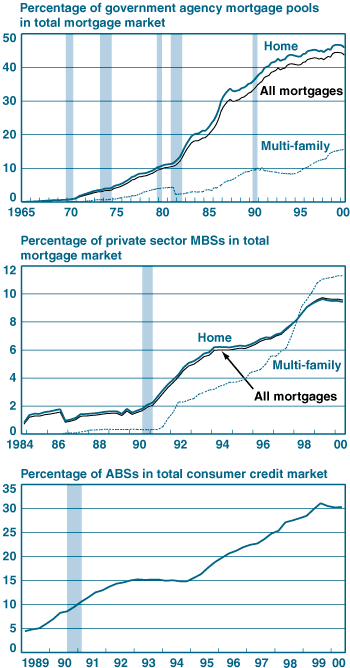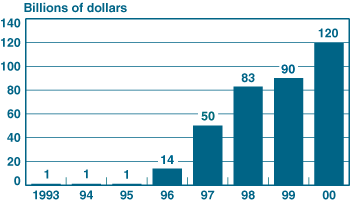| Recapping an article from the May 2002 issue |
|
|
| of the Economic Policy Review, Volume 8, Number 1 | View full article |
|
|
|
13 pages / 556 kb | |
|
Author: Arturo Estrella |
Disclaimer | |
| Index of executive summaries |
|
Overview The author investigates whether the growth in asset securitization over the past few decades has influenced the effectiveness of monetary policy. In particular, he considers whether a monetary policy move by the central bank, such as a raising or lowering of the federal funds rate, has an ultimate effect on the economy that differs from its effect before the advent of securitization. The analysis suggests that, in the mortgage markets, the effect of policy actions on real output (GDP) has weakened with increased securitization. However, the decline in the influence of policy does not seem to be associated with the Federal Reserve's control over interest rates. Rather, it is more likely related to non-interest-rate effects, such as the volume of liquidity in the markets or the supply of credit. Background Most mainstream views of the monetary policy transmission mechanism contend that the central bank influences the economy by affecting the pricing or the volume of credit instruments, or of financial assets more generally. At the same time, the credit markets are influenced significantly by securitization (chart). Financial institutions wishing to remove assets from their books—to reduce regulatory requirements on capital or to improve liquidity, for example—may do so through securitization. In a typical securitization, credit market assets, such as home mortgages originated by a bank, are pooled with many similar assets into a security that is sold to investors. Securitization first took hold in the home mortgage markets in the 1970s (chart); the phenomenon has experienced dramatic growth since then (chart). Argument and Methodology According to the author, if monetary policy operates through the credit markets—and if securitization has transformed these markets over the past few decades—securitization may have had important effects on the transmission mechanism. Furthermore, if these effects are present, it is useful to investigate whether securitization matters in practice. The study uses data corresponding to U.S. mortgage securitizations to test the hypothesis that increased securitization reduces monetary policy's ability to produce real economic effects. As part of the analysis, the author employs two equations: one testing whether the extent of securitization has affected the sensitivity of output to changes in the federal funds rate, the other testing if such changes are due to reduced Federal Reserve control over mortgage rates or to liquidity or credit effects. Findings The results suggest that although the direct influence of monetary policy on the real economy through interest rates has declined with increased securitization, the decline does not seem to be associated with a direct pricing effect through mortgage interest rates. In fact, the evidence suggests that the effects of changes in the federal funds rate evidently are transmitted more directly to mortgage rates in the presence of higher levels of securitization. Thus, the author concludes that the weakening in the influence of policy is more likely related to the volume of liquidity or the supply of credit, rather than to direct interest rate effects. |
|
|
|
|
|
|
| Growth of the Mortgage-Backed Securities Market Billions of Dollars |
|

Sources: Government National Mortgage Association (GNMA); Federal National Mortgage Association (FNMA); Federal Home Loan Mortgage Corporation (FHLMC). |
|
|
|
Securitized Proportion of Mortgage and Consumer Credit Markets
Source: Board of Governors of the Federal Reserve System, Flow of Funds database. |
|
|
|
New Issuances of Collateralized Debt Obligations
Source: Moody’s Investors Service. |
|
|
Commentary on article by Sonya W. Stanton |
|
| Disclaimer | |
|
The views expressed in this article are those of the author and do not necessarily reflect the position of the Federal Reserve Bank of New York or the Federal Reserve System. |
|










